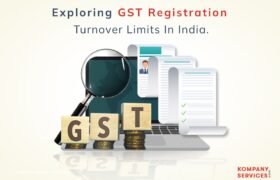Although there is a GST number known as GSTIN, PANs are still relevant documents for income tax purposes. It is given to those who are in charge of gathering and storing GST. The department may decide to cancel on its own, or the registered individual may request that their registration be canceled. The legal heirs of a registered individual may request cancellation in the event of their death. There are some situations where a taxpayer might not require a GSTIN. Taxpayers may request the cancellation of the GST registration number in such a case.
GSTIN Cancellation and Surrender
Regarding the GSTIN revocation, there were two main ideas. A person may choose to voluntarily relinquish their Goods and Service Tax Identification Number (GSTIN) or have it revoked by a GST officer if they are using it to collect and submit GST to the government. It only occurs in the event that the taxpayer disobeys any of the Act’s guidelines or requirements. Taxpayers can simply submit surrender forms and the required information online for voluntary surrender.
Application for Surrender of the GST Registration
The following individuals may submit an application to cancel their Indian-obtained GST registration.
- According to section 22 of the CGST Act, every registered individual has a GSTIN.
- In the event that a registered person passes away, their legal heir will be notified.
However, a registered supplier that voluntarily obtained a GSTIN while not being compelled to do so may only seek for registration surrender after a year has passed.
What are the requirements to apply for a GSTIN surrender?
The conditions under which a GST registration may be surrendered or cancelled are outlined in Section 29 of the CGST Act of 2017. The conditions are as follows:
- The business has been stopped or shut down entirely by the registered owner.
- The registered person must now renounce his old GSTIN and apply for new registration for the new firm since he has merged the previous business.
- A business’s PAN changes when its structure or constitution changes. Since GSTIN is PAN-based, all registrations will be forfeited in the event that a PAN is changed. A new registration is therefore necessary.
- For any individual whose annual revenue above ₹20 lakhs for services or ₹40 lakhs for commodities, they must obtain a GSTIN.
- Anything further the petitioner is able to convincingly demonstrate in the surrender application
Information about the GST Registration Surrender
Within 30 days after the incident that necessitates the surrender of registration, the GST registration may be cancelled or surrendered using the form GST REG 16. Important information that needs to be on the form is the following:
- The email address and working mobile number, as well as the communication address.
- The rationale behind the applicant’s request to relinquish their registration.
- Specifics of the held stock.
- the specifics of the input tax that was applied to the stock that was in possession.
- They have information on input tax credits and capital goods.
- In the event of a demerger, amalgamation, or merger, information about the new company.
- Information from the recently completed GST return.
- If appropriate, mention the amount of the GST liability and include the payment information.
- No GSTR-3B, GSTR-1, or GST yearly returns ought to be overdue.
The process for Surrendering GSTIN
The application for surrender or cancellation of GST registration must be completed in accordance with these instructions.
- Go to https://www.gst.gov.in/ to access the GST portal first. Enter your user ID and password to log in.
- On the dashboard, choose “services” and then “application for cancellation.”
- Under “application for cancellation,” the portal will display three tabs, which are as follows:
- Give basic information like your business address, mailing address for future correspondence, working email address, and phone number.
- Click “save and continue” once the basic details section has been completed.
- It is now time to complete the “Cancellation details” tab on the next screen.
- A list with a drop-down menu offers various explanations for why the registration was cancelled. Select the appropriate choice and enter the information requested by the option that you have chosen.
- It’s time for the last tab, “Verification,” now. The applicant must attest under this page that all of the information supplied above is accurate and true. Name the location and choose the designated signatory.
- The EVC option or a digital signature can be used to verify the application. For corporations and limited liability partnerships, a digital signature is required (LLPs).
- An acknowledgement number and a confirmation message will be sent to the applicant. Using the number, the applicant can monitor the application’s progress.
- Following this, the case will be reviewed by the GST officer, who will then issue an order of cancellation within 30 days of the application. The order will specify the revocation of registration’s effective date.
Reasons for Not Accepting the Application
The application may be rejected by the GST officer for the following reasons:
- The application is lacking information or contains inaccurate data.
- The entire amount owed for GST is not paid.
- The new entity has not submitted an application for registration in the case of a transfer, sale, merger, demerger, or amalgamation.
The application won’t be immediately rejected by the GST officer. Initially, the applicant will receive a notification from the officer explaining the reason for the refusal. Within seven days of receiving the notification, the applicant has to correct the application.
How to Get Rid of a GST Listing?
The procedure established by the GST department in your nation must be followed in order to close a GST account. This usually entails sending in a request to cancel your registration and any necessary supporting paperwork. Before requesting to have your registration canceled, make sure that all taxes have been paid and GST returns have been filed. If there are any special guidelines or requirements for closing a GST account, it is also advisable to inquire with the GST administration.
Conclusion
The whole point of this was to give up your GST registration. You now have a general understanding of the application procedure, the conditions under which a request can be submitted to the department, and the rationale behind the denial of applications. The simple definition of cancellation of GST registration is the taxpayer’s removal from the GST register.




